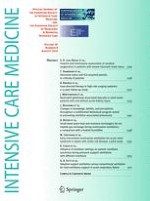01-08-2010 | Experimental
Effects of preserved spontaneous breathing activity during mechanical ventilation in experimental intra-abdominal hypertension
Published in: Intensive Care Medicine | Issue 8/2010
Login to get accessAbstract
Purpose
Ventilation problems are common in critically ill patients with intra-abdominal hypertension. The aim of this study was to investigate the effects of preserved spontaneous breathing during mechanical ventilation on hemodynamics, gas exchange, respiratory function and lung injury in experimental intra-abdominal hypertension.
Methods
Twenty anesthetized pigs were intubated and ventilated for 24 h with biphasic positive airway pressure without (BIPAPPC) or with additional, unsynchronized spontaneous breathing (BIPAPSB). In 12 animals, intra-abdominal pressure was increased to 30 mmHg for two 9 h periods followed by a 3 h pressure relief each. Eight animals served as controls and were ventilated for 24 h. Hemodynamics, gas exchange and respiratory mechanics were measured and lung injury was determined histologically.
Results
Intra-abdominal hypertension caused significant impairment of hemodynamics and respiratory mechanics in both modes. In the presence of intra-abdominal hypertension, BIPAPSB did not demonstrate superior respiratory mechanics and cardiovascular stability as compared to BIPAPPC. Although the decrease of dynamic compliance and the increase of airway pressures were mitigated, BIPAPSB failed to lower pulmonary vascular resistance and caused increased dead space ventilation (p = 0.007). Blood pressures and cardiac output increased in BIPAPSB, caused by an increase in heart rate (p < 0.001), but not in stroke volume (p = 0.06). BIPAPSB was associated with an increased breathing effort, decreased transpulmonary pressure during inspiration and lower lobe diffuse alveolar damage (p = 0.002).
Conclusions
In the presence of severe intra-abdominal hypertension, the addition of unsupported spontaneous breaths to BIPAP did not improve hemodynamic and respiratory function and caused greater histopathologic damage to the lungs.





